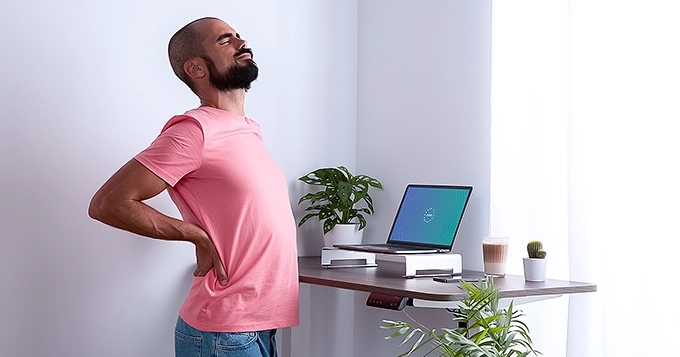It’s easy to fall into sedentary habits in today’s fast-paced world. Whether sitting at a desk for hours, binge-watching our favorite shows, or spending excessive time scrolling through social media, many of us lead increasingly sedentary lives. But what exactly does it mean to have a sedentary lifestyle, and how does it impact our body alignment?
Define Sedentary Lifestyle
A sedentary lifestyle involves prolonged periods of sitting or low physical activity levels. This can include sitting at a desk, watching television, using a computer, or driving for extended periods. Essentially, the definition of sedentary lifestyle is a daily life of minimal physical exertion.
What is a short-term consequence of a sedentary lifestyle?
Short-term consequences of this lifestyle are increased muscle stiffness and physical discomfort. Spending prolonged sitting or engaging in low physical activity levels makes our muscles tight and tense. This stiffness can lead to discomfort or pain, particularly in the neck, shoulders, lower back, and hips. Joints may also feel stiff and immobile, making movement more challenging and uncomfortable. These short-term effects serve as warning signs of the potential long-term consequences of a sedentary lifestyle if not addressed promptly.
Sedentary Lifestyle’s Impact on Body Alignment
1. Muscle Weakness and Imbalance:
When we sit for long periods, some muscles become weak and lengthened, while other muscle tissues become tight and shortened. This imbalance can lead to poor posture and misalignment of the spine.
- Tight and Shortened Muscles: When we sit for too long, our bodies tighten up, especially in certain muscles like the hip flexors and chest muscles. This tightness can restrict movement and flexibility in these muscles, contributing to poor posture and discomfort.
- Weak and Lengthened Muscles: Conversely, less-used muscles like those in the lower back, glutes, and upper back can become weak and lengthened. Weakness in these muscles reduces their ability to provide support and stability to the spine and surrounding joints.
2. Postural Changes
Sitting for extended periods can cause our posture to suffer.
- Slouched or Rounded Back: Extended periods of sedentary behavior often lead to a slouched or rounded back posture. This strains the upper back and shoulder muscles while disrupting the spine’s natural curvature.
- Forward Head Posture: Sedentary activities, particularly those involving prolonged use of electronic devices, can lead to forward head posture, straining neck and upper back muscles. This can cause pain, headaches, and stiffness over time.
- Rounded Shoulders: Sedentary behaviors that involve hunching over, such as working at a desk or driving, can contribute to rounded shoulders. This tightens chest muscles and weakens the upper back.
- Anterior Pelvic Tilt: Engaging in sedentary activities can cause your pelvis to tilt forward and the lower back to arch too much. This can cause tight hip flexors and weak gluteal muscles, impacting hip stability and causing lower back pain.
- Reduced Lower Back Curve: Sedentary behavior can flatten the lower back’s natural curve, resulting in a loss of lumbar lordosis. This puts more pressure on spinal discs and facet joints, possibly leading to discomfort and pain in the lumbar region or lower back.
- Tight Hip Flexors and Hamstrings: Prolonged periods of inactivity tighten hip flexors and hamstrings, impacting hip mobility and pelvic alignment. It can also raise your risk of lower back and hip pain.
3. Joint Stiffness
Lack of movement contributes to joint stiffness and immobility.
As joints (including the spine, hips, knees, and shoulders) become stiff due to lack of movement, the range of motion decreases, making it challenging to sustain correct posture.
For instance, stiff hip joints can strain the lower back muscles, contributing to pelvic misalignment and discomfort. Similarly, stiff shoulder joints may increase tension in the neck and upper back muscles, leading to rounded shoulders and forward head posture.
4. Increased Risk of Chronic Conditions
Sedentary behavior not only impacts body alignment but also poses a significant risk to overall health.
Studies show that prolonged sitting increases your risk of various chronic conditions, including obesity, cardiovascular disease, diabetes, and musculoskeletal disorders. These conditions can further exacerbate issues with body alignment and overall health.
How to Avoid a Sedentary Lifestyle at Home?
Here are practical steps to reduce sedentary behavior and enhance your health:
- Climb the stairs instead of riding the elevators or escalators
While elevators and escalators offer convenience, they don’t contribute anything good to your health.
In a 2017 study, researchers discovered that stair climbing, identified as a vigorous-intensity physical activity, consumes more calories per minute compared to jogging.
Climbing stairs can significantly benefit your heart, muscles, bones, joints, and lungs. Stairs are readily available almost everywhere, providing a cost-effective and accessible means to combat a sedentary lifestyle.
- Stand when you can
Instead of always sitting, try standing more often. Standing not only strengthens muscles and burns more calories than sitting but also helps improve posture, so try to stand whenever possible. For example, switch to a standing desk or use a tall table if you’re at a computer all day. Stand during phone calls, TV time, or while doing chores like folding laundry.
- Park at the far end
Parking your car further away from your destination, as long as it’s safe, is a simple way to increase your daily steps.
Like opting for stairs over elevators, if you have the opportunity and time to walk a bit farther, you take a simple step towards improving your physical health. Moreover, walking across the parking lot or around the block from your office offers a chance to enjoy the outdoors, soak up the sun, and appreciate the changing seasons, which can also improve your mental well-being.
- Do your chores
Have you ever found yourself unexpectedly sweaty after sweeping, organizing, or cleaning tasks? Housework can be quite a workout.
These chores not only maintain a clean home but also involve physical activity. So, instead of seeing them as burdensome tasks to delay, try considering them as opportunities for daily movement. For instance, consider cleaning your kitchen instead of heading straight to the couch after dinner. Activities like washing dishes and wiping countertops involve standing and can add to your daily activity.
Other chores like sweeping the floors, taking out the garbage, and vacuuming are even more physically active. You can increase intensity by picking up the pace while vacuuming or tidying up the house.
- Plant a garden
The American Heart Association classifies general gardening as moderate-intensity physical activity.
Gardening requires significant physical effort, as any gardener can attest. While it’s mentally and spiritually stimulating, it also provides an enjoyable way for many people to stay physically active.
If you have space, starting a garden in your backyard is a great option. But if not, there are alternative ways to get involved. For instance, you can volunteer at your local community garden. Many cities, school districts, and nature centers welcome volunteers to assist with planting and maintenance tasks.
- Exercise Regularly
As health guidelines recommend, you should aim for at least 150 minutes of moderate-intensity exercise per week. Incorporate activities that strengthen and stretch your muscles, such as yoga, Pilates, or weight training.
- Use a fitness tracker
If you struggle to get active, consider using wearable devices such as a pedometer or a smartwatch. These devices monitor your daily steps and send reminders to help you meet movement and standing goals. Being aware of your activity can help you identify sedentary patterns and find ways to move more.
Advanced fitness trackers offer features beyond step counting, such as calorie tracking, activity monitoring, goal setting, and even heart rate and sleep tracking. Alternatively, smartphone apps provide similar functions, often for free, making it easier to track activity without a wearable device.
Conclusion
In conclusion, a sedentary lifestyle can significantly impact body alignment, leading to muscle weakness, postural changes, joint stiffness, and an increased risk of chronic conditions. However, incorporating sedentary lifestyle solutions into our daily routines can mitigate these effects and maintain better overall health and well-being. So, let’s consciously break free from sedentary habits and keep our bodies aligned and healthy for years.











